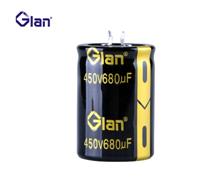
The aluminum oxide layer is very thin by electroplating on the aluminum layer relative to the voltage applied to it, and is easily broken down, causing the capacitor to fail. The company is located in:
The aluminum oxide layer can withstand a positive DC voltage and can easily fail in seconds if it is subjected to a reverse DC voltage. This phenomenon is called 'ValveEffect', which is why the polarity of the aluminum electrolytic capacitor is the cause. If both electrodes of the electrolytic capacitor have an oxide layer, a non-polar capacitor is formed. The company is located in:
Many articles have reported the mechanism of the threshold voltage reversal voltage of aluminum electrolytic capacitors, called hydrogen ion theory. When the electrolytic capacitor is subjected to reverse DC voltage, the cathode of the electrolyte is subjected to the forward voltage while the oxide layer is subjected to the negative voltage , The hydrogen ions gathered in the oxide layer will pass through the medium to reach the boundary of the medium and the metal layer and be converted into hydrogen gas. The expansion force of hydrogen causes the oxide layer to fall off, so that the current directly flows through the capacitor after breakdown of the electrolyte and the capacitor fails. DC voltage is very small, 1 ~ 2V in the role of reverse DC voltage, aluminum electrolytic capacitors in a few seconds due to hydrogen ion effect and immediate failure. Conversely, when the electrolytic capacitor to withstand the forward voltage, negative ions build-up between the oxide layer, because the diameter of the anion is very large, it does not breakdown oxide, it can withstand higher voltages.

Glossary:
1. Anode (anode): Anodized aluminum layer, that is, the positive electrolytic capacitor. 2. Cathode (cathode): electrolyte layer. The company is located in:
3. Dielectric (Dielectricdi): aluminum oxide layer attached to the surface of the aluminum layer. The company is located in:
4. Cathode Foil: The electrolyte is connected to an external layer that does not require oxidation during fabrication, but in practice aluminum is naturally oxidized as it is easily oxidized during the etch Layer, the oxide layer can withstand 1 ~ 2v voltage. The company is located in:
5. Separator (spacerpaper): Isolate the cathode and anode, so that they do not directly shorted, and absorb a certain amount of electrolyte.
Copright & copy 2018 GLAN ELECTRONICS CO.,LTD All Rights Reserved.